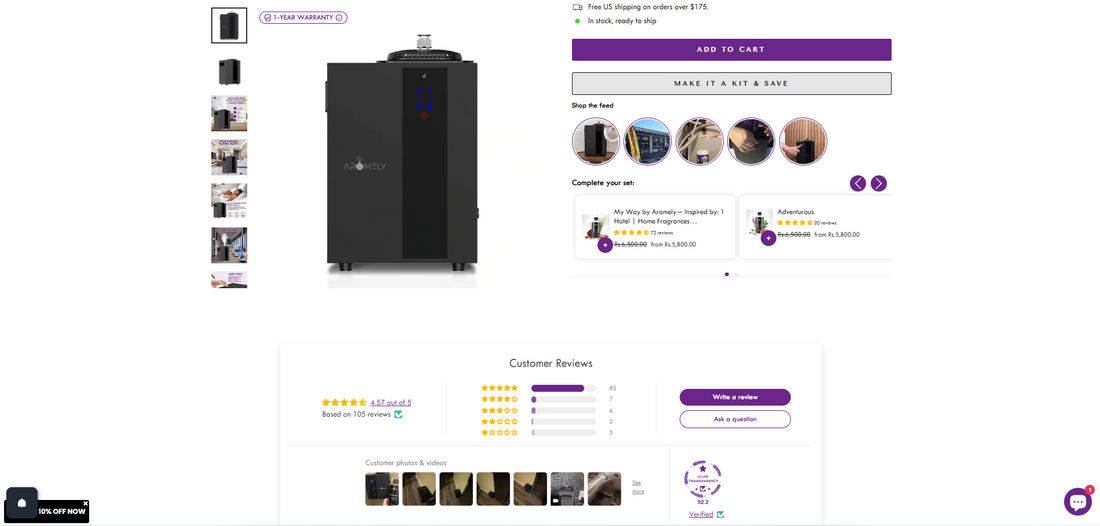
From $72 to $119: How PDP flow redesign boosted AOV by 65%
Problem (Slow store, low conversion)
Why PDP design = revenue on Shopify
Your product detail page (PDP) is where intent becomes action. If it’s cluttered, unclear, or doesn’t guide the shopper to build value, you’re leaving money on the table. Aromely’s PDPs were static and choice-heavy — shoppers faced choice paralysis when bundling, and average order value (AOV) flatlined at $72.49.
We often see this: brands invest in ads and traffic, but PDPs act more like static product leaflets than conversion engines. Without structure, shoppers stall, browse, and bounce. The key is to turn the PDP into a guided, frictionless upsell environment that encourages completing a high-value purchase.
The three conversion killers we found at Aromely
- No guided path to higher AOV — No clear “bundle builder” flow, so most users purchased a single product.
- Category overwhelm — Shoppers had to manually scroll through all scents; no quick category exploration.
-
Low recurring purchase prompts — “Subscribe & Save” was buried and under-utilized.
Process (Tools & Techniques)
This is the exact PDP workflow we used to redesign Aromely’s experience. The theme: guide the user through a simple, rewarding bundle build, keep the cart visible, and add subtle nudges toward recurring purchases.
1) Guided bundling flow — MAKE IT A SAVE
We added a custom PDP CTA: MAKE IT A SAVE.
This triggers a 3-step progress bar (1 → 2 → 3) showing the shopper how close they are to completing a 3-product kit, with a clear value incentive.
How to implement in Shopify:
- Use a PDP modal triggered by a custom CTA.
- Maintain state persistence so the cart remembers progress between steps.
- Use event-driven updates for immediate feedback.
What to watch:
- Drop-off rates between steps.
- AOV change per completed kit.

2) Dynamic category tabs for faster scent discovery
Below the progress bar, we introduced Best Sellers, Woody, Fruity, Floral, Citrus tabs — instantly filter products without leaving the modal. This reduces friction and speeds decision-making.
How to implement in Shopify:
- Dynamically load products via AJAX in the modal.
- Use debounced click events to avoid performance hits.
What to watch:
- Category click-through rates.
- Time-to-add from modal open.

3) In-modal cart controls — keep it actionable
Inside the bundle modal, shoppers can:
- See product ID and details.
- Adjust quantity (+ / −).
- Tick a Subscribe & Save (10% OFF) checkbox.
These micro-interactions remove the need to go back and forth between cart and PDP, making commitment faster.
How to implement in Shopify:
- Real-time cart updates via AJAX.
- Debounced quantity changes to reduce server calls.
- Ensure subscription widget loads instantly.
What to watch:
- Subscribe & Save opt-in rate.
- Quantity changes per user session.

Results (measurable numbers)
The redesigned PDP delivered a clear and measurable impact: Aromely’s average order value jumped from $72.49 to $119.61, representing an absolute lift of $47.12 and a relative increase of 65.0%. Alongside the revenue boost, PDP engagement metrics improved significantly, with shoppers spending more time interacting with the guided bundle flow and fewer users abandoning mid-selection. The combination of progress-driven upselling, dynamic category navigation, and visible in-modal cart controls reduced friction, encouraged multi-item purchases, and increased recurring subscription opt-ins, all without relying on discounts.
Absolute lift (in $)
$119.61 − $72.49 = $47.12
Relative lift (% increase)
(47.12 ÷ 72.49) × 100 = 65.0%
No gimmicks. No inflated numbers. Just structured UX, fast feedback loops, and the right nudge at the right time.
What these numbers say (deep dive)
A 65% AOV lift tells us the new PDP flow didn’t just improve upsells — it rewired the shopper’s purchase path. By replacing static “add to cart” actions with a guided, gamified kit-building experience, we removed decision friction and added perceived value.
